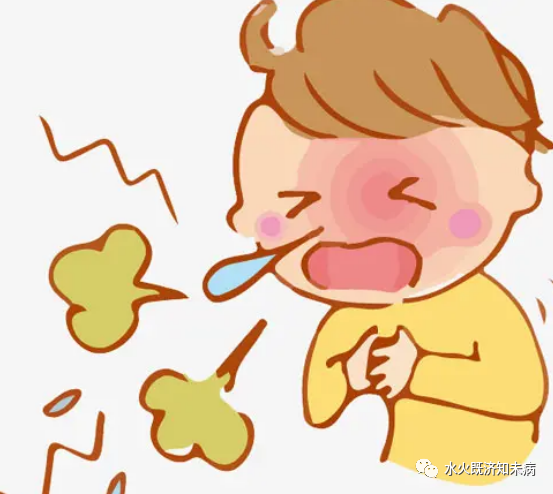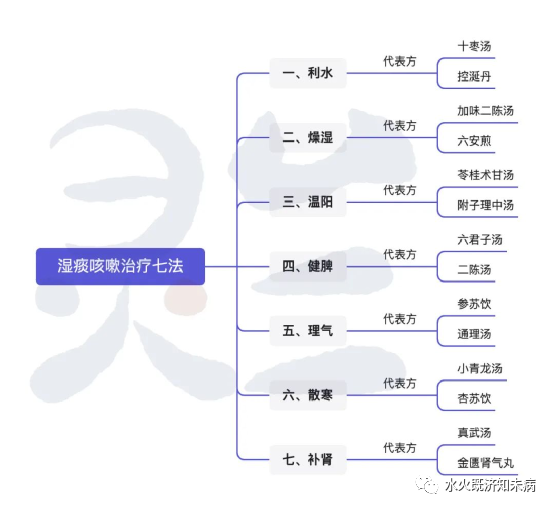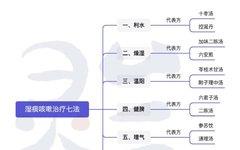
Phlegm-damp cough is a common syndrome of cough. It is often caused by excessive consumption of cold foods, which injures the Spleen Yang, or by a pre-existing deficiency of Spleen and Kidney Yang, combined with the invasion of cold-damp pathogens. This leads to the Spleen’s inability to transport fluids, resulting in the accumulation of dampness and phlegm, which then obstructs the Lung, causing cough. The symptoms include cough, copious and thin phlegm that is easy to expel, chest tightness, greasy tongue coating, slippery pulse, reduced appetite, and aversion to cold foods. 1. The following are seven methods for treating phlegm-damp cough:(1) Promote Water MetabolismAncient texts state, “Accumulated water forms phlegm, and phlegm condenses into dampness.” Since the root of phlegm is water, promoting water metabolism can eliminate the source of phlegm.Representative formulas include Shizao Decoction (十枣汤) and Kongyan Dan (控涎丹). Shizao Decoction focuses on water accumulation in the chest and abdomen, while Kongyan Dan addresses stagnation of water in the chest diaphragm.(2) Dry DampnessStagnant dampness can lead to phlegm formation, thus drying dampness is one of the fundamental methods for treating phlegm.Representative formulas include Jiawei Erchen Decoction (加味二陈汤) and Liu’an Decoction (六安煎).(3) Warm YangWater and dampness are considered Yin pathogens, which can only disperse when warmed. Therefore, warming Yang to transform phlegm-damp is a common method for treating phlegm-damp cough.Representative formulas include Linggui Zhugan Decoction (苓桂术甘汤) and Fuzhi Lizhong Decoction (附子理中汤).(4) Strengthen the SpleenSince the Spleen belongs to the Earth element, it can both drain dampness and control water. The transportation of dampness relies on the proper functioning of Spleen Qi to prevent the generation of dampness and phlegm. Thus, strengthening the Spleen is a fundamental method for treating phlegm-damp.Representative formulas include Liu Junzi Decoction (六君子汤) and Erchen Decoction (二陈汤).(5) Regulate QiThis refers to regulating Lung Qi. The Lung governs the Qi of the entire body and is the source of water. Lung Qi should descend smoothly; when Qi flows, water flows, and phlegm-damp disperses along with Qi, preventing obstruction of the Lung and cough. Therefore, regulating Qi is an important method for transforming phlegm-damp.Representative formulas include Shen Su Decoction (参苏饮) and Tongli Decoction (通理汤).(6) Disperse ColdPhlegm-damp cough often results from internal injury combined with external pathogens. If there is a pre-existing condition of phlegm-damp or water retention, and an external cold pathogen invades, the combined attack can exacerbate dampness and phlegm. In this case, dispersing cold is particularly important.Representative formulas include Xiao Qinglong Decoction (小青龙汤) and Xing Su Decoction (杏苏饮).(7) Tonify the KidneyThe Kidney stores the original Yang of the body and governs water. The transformation of Spleen Yang relies on the warming function of Kidney Yang. When Kidney Qi flows, Spleen Qi operates, and water is naturally transformed. Therefore, tonifying the Kidney is fundamental for treating water and dampness.Representative formulas include Zhenwu Decoction (真武汤) and Jinkui Shenqi Pill (金匮肾气丸).2. Clinical Cases(1) Patient Zhai, female, 45 years old.Initial diagnosis on November 13, 1962: cough, chest tightness, shortness of breath, headache, no thirst, loose stools for one week, white greasy tongue coating, and slippery pulse. This indicates deficiency of Yang and accumulation of water-dampness. The treatment should focus on warming Yang (transforming phlegm-damp).The formula used was Jiawei Linggui Zhugan Decoction: 9g Poria (茯苓), 6g Cinnamon Twig (桂枝), 6g White Atractylodes (白术), 7.5g Tangerine Peel (陈皮), and 4.5g Fritillaria Bulb (川贝). Decoct and take. Improvement was seen after one dose, and complete recovery after three doses.Note:Linggui Zhugan Decoction is a classic formula from the Treatise on Cold Damage and Miscellaneous Diseases, widely used for external pathogenic transformations and internal miscellaneous diseases. The cause of this case, regardless of whether it followed a cold damage or was an internal miscellaneous disease, is due to Yang deficiency and water-damp accumulation. The treatment method belongs to the warming method of transforming phlegm-damp, as stated in the Essentials of the Golden Chamber: “For phlegm-damp, one should use warming herbs to harmonize it.” The main herb, Poria, is sweet and bland, which strengthens the Spleen, promotes water metabolism, and transforms dampness. However, since dampness is a Yin pathogen, it requires warmth to disperse. Therefore, the assistant herb, Cinnamon Twig, is used to warm Yang and descend Qi, working in conjunction with Poria to both warm Yang and assist in transforming phlegm, while also unblocking Yang Qi and releasing the exterior. This is the core of the warming method for transforming phlegm-damp. White Atractylodes is added to strengthen the Spleen and dry dampness to assist in transportation. Licorice is included to harmonize the herbs, tonify Qi, and regulate the Spleen and Stomach’s ascending and descending functions. Tangerine Peel regulates Qi and dries dampness, harmonizing and transforming phlegm to assist the functions of Poria and Atractylodes. Fritillaria Bulb is a key herb for stopping cough and transforming phlegm in the Lung. The entire formula is composed of refined herbs, with a rigorous combination that is warm but not hot, and promotes without being harsh, making it an excellent formula for treating phlegm-damp cough with warming methods.(2) Patient Miao, male, 42 years old.Initial diagnosis on March 30, 1963: cough and shortness of breath for three months, copious white sticky phlegm, chest tightness, and abdominal distension, with white greasy tongue coating and slippery pulse. This indicates obstruction by phlegm-damp. The treatment should focus on drying dampness (transforming phlegm).The formula used was Jiawei Erchen Decoction: 7.5g Pinellia (半夏), 7.5g Tangerine Peel (陈皮), 9g Poria (茯苓), 7.5g Cinnamon Twig (桂枝), 7.5g White Atractylodes (白术), and 3g Honey-fried Licorice (炙甘草).Decoct and take. Cough stopped after two doses, shortness of breath and distension resolved after four doses, and complete recovery after six doses.Note:This patient had phlegm-damp generated from the Spleen and Stomach, which then obstructed the Lung, leading to cough with copious white sticky phlegm. Elder Li often used the Erchen Decoction from the Classic of Formulas to treat cough and all diseases caused by phlegm-damp obstruction.Phlegm-damp originates from Spleen deficiency and excess dampness, hence White Atractylodes is added to strengthen the Spleen and dry dampness. The clever use of Cinnamon Twig serves two purposes: it can internally assist Yang Qi to help transform dampness, and it can externally release the exterior to resolve the Lung, allowing phlegm-damp to be eliminated and cough to cease.
1. The following are seven methods for treating phlegm-damp cough:(1) Promote Water MetabolismAncient texts state, “Accumulated water forms phlegm, and phlegm condenses into dampness.” Since the root of phlegm is water, promoting water metabolism can eliminate the source of phlegm.Representative formulas include Shizao Decoction (十枣汤) and Kongyan Dan (控涎丹). Shizao Decoction focuses on water accumulation in the chest and abdomen, while Kongyan Dan addresses stagnation of water in the chest diaphragm.(2) Dry DampnessStagnant dampness can lead to phlegm formation, thus drying dampness is one of the fundamental methods for treating phlegm.Representative formulas include Jiawei Erchen Decoction (加味二陈汤) and Liu’an Decoction (六安煎).(3) Warm YangWater and dampness are considered Yin pathogens, which can only disperse when warmed. Therefore, warming Yang to transform phlegm-damp is a common method for treating phlegm-damp cough.Representative formulas include Linggui Zhugan Decoction (苓桂术甘汤) and Fuzhi Lizhong Decoction (附子理中汤).(4) Strengthen the SpleenSince the Spleen belongs to the Earth element, it can both drain dampness and control water. The transportation of dampness relies on the proper functioning of Spleen Qi to prevent the generation of dampness and phlegm. Thus, strengthening the Spleen is a fundamental method for treating phlegm-damp.Representative formulas include Liu Junzi Decoction (六君子汤) and Erchen Decoction (二陈汤).(5) Regulate QiThis refers to regulating Lung Qi. The Lung governs the Qi of the entire body and is the source of water. Lung Qi should descend smoothly; when Qi flows, water flows, and phlegm-damp disperses along with Qi, preventing obstruction of the Lung and cough. Therefore, regulating Qi is an important method for transforming phlegm-damp.Representative formulas include Shen Su Decoction (参苏饮) and Tongli Decoction (通理汤).(6) Disperse ColdPhlegm-damp cough often results from internal injury combined with external pathogens. If there is a pre-existing condition of phlegm-damp or water retention, and an external cold pathogen invades, the combined attack can exacerbate dampness and phlegm. In this case, dispersing cold is particularly important.Representative formulas include Xiao Qinglong Decoction (小青龙汤) and Xing Su Decoction (杏苏饮).(7) Tonify the KidneyThe Kidney stores the original Yang of the body and governs water. The transformation of Spleen Yang relies on the warming function of Kidney Yang. When Kidney Qi flows, Spleen Qi operates, and water is naturally transformed. Therefore, tonifying the Kidney is fundamental for treating water and dampness.Representative formulas include Zhenwu Decoction (真武汤) and Jinkui Shenqi Pill (金匮肾气丸).2. Clinical Cases(1) Patient Zhai, female, 45 years old.Initial diagnosis on November 13, 1962: cough, chest tightness, shortness of breath, headache, no thirst, loose stools for one week, white greasy tongue coating, and slippery pulse. This indicates deficiency of Yang and accumulation of water-dampness. The treatment should focus on warming Yang (transforming phlegm-damp).The formula used was Jiawei Linggui Zhugan Decoction: 9g Poria (茯苓), 6g Cinnamon Twig (桂枝), 6g White Atractylodes (白术), 7.5g Tangerine Peel (陈皮), and 4.5g Fritillaria Bulb (川贝). Decoct and take. Improvement was seen after one dose, and complete recovery after three doses.Note:Linggui Zhugan Decoction is a classic formula from the Treatise on Cold Damage and Miscellaneous Diseases, widely used for external pathogenic transformations and internal miscellaneous diseases. The cause of this case, regardless of whether it followed a cold damage or was an internal miscellaneous disease, is due to Yang deficiency and water-damp accumulation. The treatment method belongs to the warming method of transforming phlegm-damp, as stated in the Essentials of the Golden Chamber: “For phlegm-damp, one should use warming herbs to harmonize it.” The main herb, Poria, is sweet and bland, which strengthens the Spleen, promotes water metabolism, and transforms dampness. However, since dampness is a Yin pathogen, it requires warmth to disperse. Therefore, the assistant herb, Cinnamon Twig, is used to warm Yang and descend Qi, working in conjunction with Poria to both warm Yang and assist in transforming phlegm, while also unblocking Yang Qi and releasing the exterior. This is the core of the warming method for transforming phlegm-damp. White Atractylodes is added to strengthen the Spleen and dry dampness to assist in transportation. Licorice is included to harmonize the herbs, tonify Qi, and regulate the Spleen and Stomach’s ascending and descending functions. Tangerine Peel regulates Qi and dries dampness, harmonizing and transforming phlegm to assist the functions of Poria and Atractylodes. Fritillaria Bulb is a key herb for stopping cough and transforming phlegm in the Lung. The entire formula is composed of refined herbs, with a rigorous combination that is warm but not hot, and promotes without being harsh, making it an excellent formula for treating phlegm-damp cough with warming methods.(2) Patient Miao, male, 42 years old.Initial diagnosis on March 30, 1963: cough and shortness of breath for three months, copious white sticky phlegm, chest tightness, and abdominal distension, with white greasy tongue coating and slippery pulse. This indicates obstruction by phlegm-damp. The treatment should focus on drying dampness (transforming phlegm).The formula used was Jiawei Erchen Decoction: 7.5g Pinellia (半夏), 7.5g Tangerine Peel (陈皮), 9g Poria (茯苓), 7.5g Cinnamon Twig (桂枝), 7.5g White Atractylodes (白术), and 3g Honey-fried Licorice (炙甘草).Decoct and take. Cough stopped after two doses, shortness of breath and distension resolved after four doses, and complete recovery after six doses.Note:This patient had phlegm-damp generated from the Spleen and Stomach, which then obstructed the Lung, leading to cough with copious white sticky phlegm. Elder Li often used the Erchen Decoction from the Classic of Formulas to treat cough and all diseases caused by phlegm-damp obstruction.Phlegm-damp originates from Spleen deficiency and excess dampness, hence White Atractylodes is added to strengthen the Spleen and dry dampness. The clever use of Cinnamon Twig serves two purposes: it can internally assist Yang Qi to help transform dampness, and it can externally release the exterior to resolve the Lung, allowing phlegm-damp to be eliminated and cough to cease.
This is a platform for sharing TCM knowledge; a place for differentiation and discussion of treatment. Friends who love TCM, please follow and share!!!


